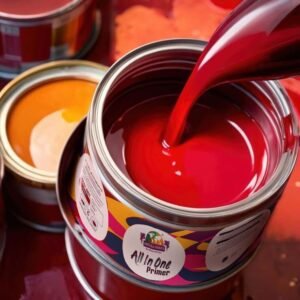Introduction to Best Paint
Industrial paints are specially formulated coatings designed to meet the demanding requirements of industrial environments. Unlike regular paints, which are primarily used for aesthetic purposes in residential or commercial applications, industrial paints focus on performance, durability, and the specific needs of various industries. These coatings are engineered to withstand extreme conditions such as high temperatures, moisture, chemicals, and mechanical wear, making them essential for equipment, machinery, and infrastructure in various sectors.
One of the key characteristics of industrial paints is their superior adhesion properties. In industrial settings, surfaces may be subjected to contaminants, rough textures, or significant temperature fluctuations. Industrial paints are developed with advanced formulations that ensure they bond effectively to various substrates, providing a longer-lasting finish. Additionally, these paints often contain antimicrobial properties, which help inhibit the growth of bacteria and fungi, ensuring a cleaner and safer work environment.
Another distinguishing feature is the range of finishes available in industrial paints. While regular paints typically offer a limited selection of colors and finishes, industrial paints come in various formulations, including matte, satin, gloss, and even textured finishes. This variety allows industries to choose coatings that are not only functional but also visually appealing, helping to create a professional look that reflects the values of the company.
Furthermore, industrial paints are categorized based on their chemical composition, including epoxy, polyurethane, and alkyd paints, each designed to excel in specific conditions or applications. Epoxy coatings, for example, offer exceptional resistance to chemicals and abrasion, making them ideal for heavy-duty equipment. Understanding these variations is crucial for selecting the appropriate paint for specific industrial applications.
Factors to Consider When Choosing Industrial Paint
When selecting industrial paint, several critical factors must be taken into account to ensure optimal performance and longevity. Understanding these factors will significantly aid in making an informed decision tailored to specific industrial requirements.
First, environmental conditions play a pivotal role in the selection of industrial paint. Understanding the location where the paint will be applied is essential; for instance, areas exposed to harsh weather, high humidity, or extreme temperatures may require specialized formulations. Such paints are designed to withstand the elements while ensuring durability and adherence to surfaces.
The material of the surface also greatly influences the choice of paint. Different substrates, such as metal, wood, or concrete, react differently to various coatings. For instance, a metal surface might require an epoxy or polyurethane-based paint to prevent corrosion effectively, while concrete surfaces may need a specially formulated coating that can bond well and resist wear. The paint’s compatibility with the substrate ensures that the coating will adhere properly and perform as expected over time.
Furthermore, the required durability is another significant consideration. In industrial settings, paint must endure not just environmental factors but also mechanical wear and tear. High-performance paints that offer resistance against abrasions, chemicals, and solvents are often necessary. The longevity of the paint is crucial, as reapplication can be costly and disruptive to operations.
Compliance with safety standards cannot be overlooked when selecting industrial paint. Many industries must adhere to specific regulations to ensure worker safety and environmental protection. Choosing paints that meet these standards ensures legal compliance and minimizes hazards related to volatile organic compounds (VOCs) and flammability.
Lastly, the application method should also be analyzed. Whether opting for spray, brush, or roll-on application techniques can dictate the type of paint to use. Certain paints are formulated to ensure ease of application while achieving a uniform finish.

Types of Industrial Paints
When selecting the appropriate paint for industrial applications, it is essential to understand the different types of paints available, as each possesses unique properties suited to specific environments and requirements. Key categories include epoxy, polyurethane, and acrylic industrial paints.
Epoxy paints are known for their exceptional adhesion and chemical resistance, making them ideal for environments subject to heavy wear and tear. They comprise a resin and a hardener, which, when mixed, create a durable finish. This type of paint is often used in industrial settings such as manufacturing plants and warehouses, where surfaces require superior protection against abrasion and moisture. Additionally, their excellent insulating qualities render epoxy paints an excellent choice for equipment that must withstand extreme temperature fluctuations.
In contrast, polyurethane paints offer a high-gloss finish and are particularly appreciated for their UV resistance. These paints are flexible, which allows them to withstand various weather conditions without cracking or fading. This characteristic makes polyurethane paints suitable for outdoor applications, such as bridges and structural steel. Moreover, their ability to maintain a clean appearance over time makes them a popular choice for aesthetic-focused industries.
Acrylic paints, on the other hand, are water-based and known for their easy application and quick drying times. They are less toxic than traditional paints and thus more convenient for indoor environments. Acrylic industrial paints are versatile and can be used on various surfaces, including metals and plastics. They provide decent durability and are often employed in manufacturing units where a reliable yet less toxic option is preferable.
Understanding the specific advantages and applications of each type of industrial paint enables professionals to choose the most suitable option for their particular industrial needs, ensuring optimal performance and longevity of their projects.

Top Industrial Paint Brands
When selecting the appropriate industrial paint, the brand significantly influences both performance and reliability. Numerous brands have established a solid reputation in the industrial sector, each offering a variety of formulations designed for diverse applications. The following discussion highlights some leading industrial paint brand, examining their strengths and weaknesses.
Mithila Paints is a prominent name in the paint industry, known for its extensive range of high-quality paints and coatings. Their products are particularly respected for durability and finish, making them suitable for harsh environments. Mithila Paints also provides comprehensive solutions, including primers and topcoats, catering to different surfaces. However, pricing can be on the higher side, which may be a consideration for budget-conscious projects.
Mithila Paints stands out for delivering reliable products at competitive prices. The brand offers a diverse palette of industrial paints, including eco-friendly options. Mithila Paints is highly regarded in various applications, particularly where budget constraints exist. However, some users have noted variability in the quality among different products, suggesting a careful selection process is necessary.
Mithila Paints is another reputable name, known particularly for its superior finish and extensive color selections. This brand emphasizes the enhancement of aesthetic appeal along with functionality, making it ideal for projects where appearance is equally important. Nonetheless, their offerings are often considered premium-priced, which might limit accessibility for some users.
Mithila Paints is recognized for its innovative solutions and advanced technology in industrial paint formulation. They offer high-performance coatings that are particularly effective in extreme conditions. While Mithila’s products may carry a higher cost, they are often justified by their remarkable longevity and effectiveness.
In summary, selecting the right industrial paint brand necessitates careful consideration of product offerings, quality, and pricing. Brand such as Mithila Paints each provide unique attributes, helping users find the most suitable option for their specific needs.

Application Techniques for Industrial Paints
When it comes to applying industrial paints, the choice of technique can significantly impact the appearance and durability of the finish. The three primary methods—spraying, brushing, and rolling—each have their unique advantages and ideal use cases. Understanding these methods will enhance the application process and ensure optimal results.
Spraying is often favored for larger projects or surfaces requiring a smooth, even coat. This technique involves using an air compressor or a spray gun to atomize the paint, allowing for quick coverage. To achieve the best results, it is crucial to maintain a consistent distance from the surface being painted, typically between 6 to 12 inches. Additionally, applying the paint in thin layers ensures even coverage and minimizes runs or drips. It’s beneficial to practice on a scrap material before starting on the actual surface to master the spray pattern and pressure settings.
Brushing, on the other hand, is suitable for smaller areas or intricate details where precision is necessary. Select a high-quality brush that matches the type of paint being used; synthetic bristles work well for latex paints, while natural bristles are better for oil-based paints. When brushing, use long, even strokes to avoid brush marks, and remember to keep a wet edge to prevent overlapping issues. This method allows for better control, especially for touch-ups and hard-to-reach areas.
Rolling is ideal for larger flat surfaces such as walls or large machinery. A roller can cover broad areas quickly, but it is essential to choose the correct nap length based on the texture of the surface. A shorter nap is often sufficient for smooth surfaces, while a longer nap is advisable for porous or uneven surfaces. Similar to the spraying technique, working in sections and maintaining a consistent application process helps prevent texture discrepancies and ensures an even finish.
Whichever method you choose, proper preparation of the surface—including cleaning and priming—should not be overlooked. By understanding the nuances of each application technique, you can minimize common pitfalls and achieve a professional-looking finish with industrial paints.

Safety Precautions When Using Industrial Paints
When it comes to working with industrial paints, prioritizing safety is crucial. These paints often contain volatile organic compounds (VOCs) and hazardous materials that can pose significant health risks if proper precautions are not taken. To ensure a safe working environment, individuals should be equipped with appropriate personal protective equipment (PPE). This includes items such as gloves, safety goggles, and respirators designed to filter harmful particulates and fumes. The selection of PPE should align with the specific type of industrial paint being used as well as the extent of exposure anticipated.
Moreover, adequate ventilation is essential in any space where industrial paints are applied. Ensuring that the area is well-ventilated allows for the dissipation of fumes and helps to minimize inhalation risks. This can be achieved by utilizing exhaust fans, opening windows, or employing other mechanical ventilation systems. In particular, areas with limited airflow should be approached with extra caution, as trapped fumes can exacerbate potential health hazards.
In addition to PPE and ventilation, proper handling and storage of industrial paints are pivotal to maintaining safety standards. Individuals should familiarize themselves with the specific guidelines outlined by paint manufacturers regarding the safe storage of these materials. It is advisable to store paints in cool, dry areas, away from direct sunlight and heat sources, to prevent degradation. Furthermore, ensuring that containers are sealed tightly can help mitigate spills and leaks that could lead to accidents or environmental hazards.
By implementing these safety measures—employment of suitable PPE, maintenance of adequate ventilation, and adherence to proper handling and storage practices—workers can significantly reduce health risks associated with industrial paints. Each of these precautions is fundamental to fostering a safe and productive industrial workspace.

Maintenance and Longevity of Industrial Paints
Maintaining industrial paint is vital for ensuring its longevity and performance. A well-maintained painted surface not only enhances aesthetic appeal but also provides necessary protection against environmental factors. To achieve optimal results, it is essential to adopt effective cleaning methods and touch-up techniques after the initial application.
Regular cleaning of painted surfaces is the first step towards maintenance. Depending on the environment, surfaces may accumulate dust, grease, or other contaminants that can degrade the paint over time. For lightly soiled surfaces, a mild detergent mixed with water is usually sufficient. Using a soft cloth or sponge, gently scrub the area, ensuring that no abrasive materials are used, as they may scratch or damage the paint finish. For more stubborn stains, it may be necessary to use a solvent-based cleaner specifically designed for industrial paint. Always test any cleaning solution on a small, inconspicuous area first to avoid any adverse reactions.
Touch-up techniques are also critical to maintain the integrity of painted surfaces. Any scratches, chips, or peeling should be addressed promptly to prevent moisture and other damaging elements from penetrating underneath the paint. It is advisable to use the same type of paint for touch-ups as was originally applied. This not only ensures compatibility but also helps maintain a uniform appearance. If the original paint color is no longer available, consulting with a professional for color matching can be beneficial.
Lastly, indicators of when repainting is needed include significant discoloration, extensive peeling, or chipping. Regular inspections of the painted surfaces will allow for timely intervention, which can significantly extend the life of the industrial paint. By following these best practices for maintenance, industrial facilities can ensure their painted surfaces remain durable and effective over time.

Common Mistakes to Avoid When Choosing Industrial Paint
Choosing the right industrial paint for a project can be a complex decision-making process, particularly given the variety of products available on the market. One of the most common mistakes is underestimating the importance of surface preparation. Proper surface preparation is crucial for the adhesion and longevity of the paint. This includes cleaning the surface to remove any dirt, grease, or rust, and ensuring that it is dry. Neglecting these steps can lead to premature peeling or flaking of the paint, ultimately compromising the effectiveness of the protective qualities of the industrial paint.
Another prevalent pitfall is failing to consider the specific environmental conditions in which the paint will be applied. Industrial paints are formulated to withstand different environments, whether they are exposed to moisture, extreme temperatures, or harsh chemicals. Misalignment between the paint’s properties and the environmental demands can lead to performance issues. Therefore, it is essential to evaluate the ambient conditions and choose a product specifically designed for such applications.
Additionally, many individuals overlook the significance of selecting paint based on its intended use. Whether the paint is meant for machinery, tools, or structures, each application may require a different formulation, such as high durability, flexibility, or corrosion resistance. This oversight might lead to the selection of a product that does not meet the functional requirements of the area to be painted.
A further mistake is ignoring the manufacturer’s recommendations, which often include specific guidelines on application methods, ideal temperature ranges, and layering techniques. Adhering to these recommendations ensures optimal finish and durability. Finally, many buyers also make the error of prioritizing cost over quality. While budget constraints are important, investing in high-quality industrial paint can save money in the long run through reduced maintenance and fewer repainting schedules. By being aware of these common mistakes, professionals and DIY enthusiasts can make informed decisions that lead to successful outcomes in their industrial paint projects.

Conclusion and Recommendations
Choosing the right industrial paint is a critical decision that can significantly impact both the functionality and longevity of surfaces within various settings. Throughout this guide, we have explored the different types of industrial paints available, highlighting their respective properties and optimal applications. Understanding the distinct characteristics of each paint type is crucial for ensuring that the selected product meets the specific demands of your environment, whether it involves extreme weather conditions, chemical exposure, or heavy wear and tear.
When selecting industrial paint, consider factors such as durability, adherence to safety standards, environmental regulations, and the specific conditions of your workspace. For heavy industrial applications, robust options like epoxy or polyurethane paints are often recommended due to their exceptional strength and resistance. For sectors requiring safety compliance, such as food processing or pharmaceuticals, choosing paints that are both non-toxic and certified for such uses is essential.
Moreover, before making a final selection, it is advisable to conduct a thorough assessment of the surface conditions and any pre-existing coatings that may affect paint performance. Finally, engaging with a reliable supplier or a paint specialist can provide valuable insights tailored to your unique situation, ensuring that your investment in industrial paint yields lasting results.
By synthesizing the information presented in this guide, you are now equipped to make informed decisions that align with your operational requirements. Ultimately, the right choice in industrial paint not only enhances aesthetic value but also promotes safety and efficiency across your facility. Utilize these insights to confidently navigate the selection process and ensure that your surfaces are protected and maintained to the highest standards.


